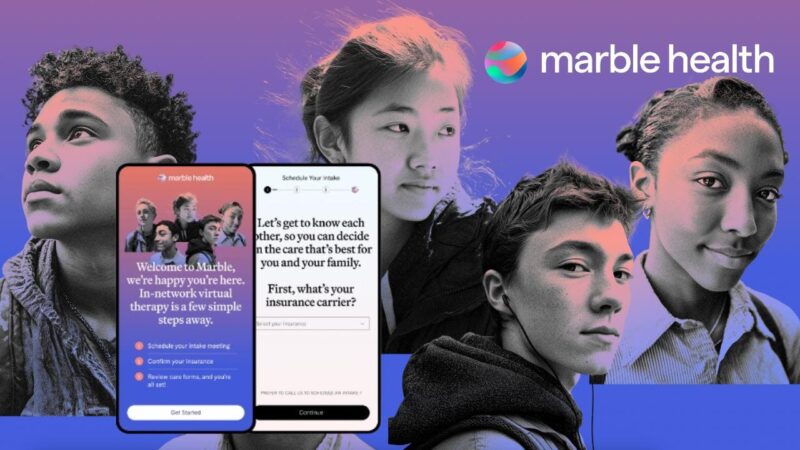Marble product image
Marble Health
A behavioral telehealth startup called Marble Health is betting on something refreshingly human: real therapists, not AI, can help solve the nation’s youth mental health crisis.
In April 2025, sixteen-year-old Adam Raine died by suicide after countless late-night conversations he’d had with ChatGPT, where the AI allegedly gave instructions on the method to do it and offered to help him craft a suicide note. The story became a national flashpoint—an indictment of the dangers of AI and a reality check on the mental health crisis young people are facing right now.
Suicide is the third-leading cause of death among U.S. high-school students, according to the CDC. Overall, 39.7% of students experienced persistent feelings of sadness and hopelessness, 28.5% experienced poor mental health, 20.4% seriously considered attempting suicide, and 9.5% attempted suicide. The prevalence among female students was higher than male students for persistent feelings of sadness or hopelessness (52.6% versus 27.7%), poor mental health (38.8% versus 18.8%), seriously considered attempting suicide (27.1% versus 14.1%), and attempted suicide (12.6% versus 6.4%).
Many Therapists Don’t Take Insurance
Despite the growing need, only 60% of psychiatrists accept new privately-insured (or Medicare) patients and just 38% accept new Medicaid patients, according to data from JAMA Psychiatry and KFF. By contrast, across primary care and most specialties, at least 80% of physicians accept new patients with private insurance (or Medicare) and at least 70% accept Medicaid. Because insurers typically reimburse mental healthcare providers at lower rates, therapists and psychiatrists are less likely to participate in insurance plans.
Against this backdrop, Marble Health was founded in 2023 by Jake Sussman and Dan Ross, two of the cofounders of Headway, a mental health startup helping adults find therapists covered by insurance. By partnering with schools and billing insurance—primarily Medicaid—Marble delivers youth therapy that families can actually access and afford. It’s a model built not on replacing clinicians with code but on giving them better tools and more reach.
Marble recently closed $15.5 million in Series A funding led by Costanoa Ventures, bringing its total capital raised to $20.5 million, in order to scale its platform nationwide and claim its slice of the $92 billion US behavioral health market.
A Crisis in the Classroom
I spoke with CEO Sussman about Marble’s journey to date.
After leaving Headway and before co-founding the business, Sussman became an elementary school English teacher in New York City, at Success Academy charter school, and experienced firsthand the challenge of youth accessing mental healthcare. With “one counselor serving six hundred students, kids were struggling and there was nowhere to send them because mental health clinics have long waitlists that never close the loop on care,” he recalls.
“The thing I hadn’t understood,” he says, “was how fragmented youth care is. Every child has this constellation of adults—a parent, a teacher, a school counselor, maybe a therapist—and none of them are talking to each other.”
That fragmentation inspired Marble’s design. The platform functions as a coordination hub: school counselors refer students, parents provide consent, and Marble matches each child to a licensed therapist for individual or group sessions conducted virtually. The company has built custom portals for both counselors and clinicians, plus an electronic health-record system tailored to adolescent care. Most crucially, Marble’s revenue comes entirely from insurance reimbursements and schools pay nothing – a model that dramatically shortens its sales cycle while expanding access.
Marble product image
Marble Health
Since launching in New York City in 2023, Marble has expanded to hundreds of schools, facilitated over 15,000 appointments, and served a few thousand students, about 75–80% covered by Medicaid. The therapist network numbers in the hundreds, most joining inbound—because they are getting a reliable flow of new patient referrals.
Market Demand From the Payer Side
Marble’s investor Amy Cheetham, a partner at Costanoa Ventures, explained that insurers are demonstrating strong interest in this market. “Every payer we spoke to listed adolescent and teen mental health as their #1 priority that they were trying to figure out solutions for, and provide better access to,” she elaborated. “They’re looking for more providers who can show measurable results and that is what Marble is doing.”
For payers, the math is straightforward: teens who can’t access therapy often land in the emergency room, where the costs are exponentially higher. “If I’m an insurance company, I have a financial imperative to create access to care for my adolescent members, because it’s preventative,” Sussman continued.
Expanding the Clinical Spectrum
Until now, Marble has focused on mild-to-moderate youth anxiety, depression, and adjustment issues. The company’s next step: psychiatric evaluation and medication management, supervised by an in-house psychiatrist who sets prescribing guardrails. “Medication can work for certain conditions when paired with therapy,” Sussman says, “but only if the prescriber and therapist actually collaborate—which rarely happens when they’re in separate systems.”
Marble product image
Marble Health
By uniting therapy and prescribing under one umbrella, Marble aims to deliver continuous, coordinated care for students whose needs escalate—a move that also deepens its payer relationships. It’s a logical, if challenging, evolution toward becoming a comprehensive youth behavioral provider addressing different types of interventions.
A Challenging Business Model to Scale
Expanding Marble’s model nationally won’t be easy. Sussman cites Texas, Illinois, and Nebraska among the next target states—regions where school counselors are similarly overwhelmed and Medicaid coverage is broad. But state level reimbursement rules, credentialing requirements, and payment timelines differ across regions, and so the administrative burden will be high.
In addition, Marble’s reimbursement-only model makes scaling more capital-intensive. Unlike some of its competitors that work with school districts and have a dual-revenue model charging the school districts up front based on a per student fixed fee, the startup depends entirely on insurance payments after care is delivered. That structure aligns Marble’s incentives with access—its revenue grows when students actually receive care. But it also subjects the company to the same administrative delays and rate constraints that discourage many clinicians from accepting Medicaid in the first place. And with these cash flow risks, Marble will need to identify low-cost sources of capital to float the business while awaiting reimbursement.
Finally, adult-focused online therapy platforms such as BetterHelp, Talkspace, and Grow Therapy are moving into the adolescent and teen segment, signaling just how large that market has become. BetterHelp—still a fully cash-pay model—has launched extensive digital campaigns targeting parents of teens. Talkspace now offers teen therapy covered by major insurers including Cigna, Aetna, Blue Cross Blue Shield and Optum, and has been adding payer relationships since its 2021 public listing. Grow Therapy, which built its provider network around accepting insurance, now includes licensed child and adolescent specialists across multiple states. Marble is of course betting that a coordinated, school-integrated model can reach the students that consumer-driven telehealth platforms overlook, but other platforms will no doubt eat into its market share.
For now, a fresh round of venture funding will allow Sussman and the team to test whether Marble’s mission-driven thesis focused on accessible therapy for students can scale nationally while balancing impact with sustainability.









